Saturday, November 15, 2014
 Turkmenbashi’s Family Mausoleum
Turkmenbashi’s Family Mausoleum
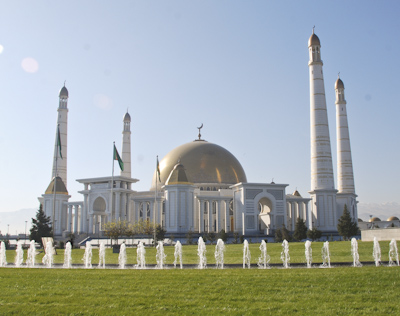 Former President Niyazov’s Personal Mosque
Former President Niyazov’s Personal Mosque
 Another View of the $100 Million Dollar Mosque
Another View of the $100 Million Dollar Mosque
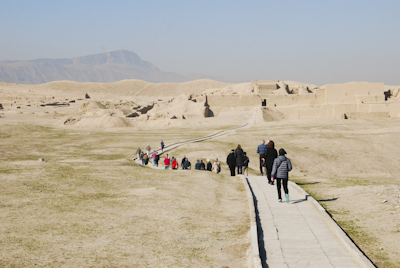 Walking to the Ancient Parthian Kingdom of Nisa
Walking to the Ancient Parthian Kingdom of Nisa
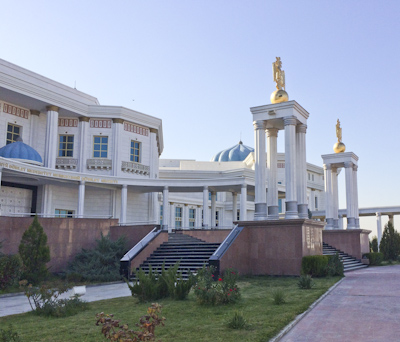 National Museum of History and Ethnography
National Museum of History and Ethnography
Friday, November 14, 2014 Sunny & 27 degrees F
 Morning Light on the Eastern Gate of Khiva
Morning Light on the Eastern Gate of Khiva
I had missed the tour of the old town of Khiva yesterday, so I was happy to feel better today and participate in the activities. We were scheduled to have a tour of the history museum within the fortress walls then we were free to explore on our own until lunch time. We were directed to meet at another hotel just outside the Western Gate at noon.
Our group entered the former Madrasah which now served as the Museum of Applied Arts. There were antique doors, stamps, tables, blankets, costumes, carpets, tiles and other artifacts which demonstrated the high level of local craftsmen and culture.
It was Friday and Khiva was bustling with tourists and shoppers. There were many tables set out everywhere with crafts and handmade wares for sale.
The group continued to the Pakhlavan Makhmud Mausoleum which is carefully preserved as a national cultural treasure and is a World Heritage Site. It is a religious center formed around the tomb of Khiva’s patron Pahlavan-Mahmud who lived from 1247 until 1326. He was a poet, philosopher and wrestler who was also known as a healer throughout Khiva, Iran, and India.
The Mausoleum was crowded with families and groups of people who had come to pray, as well as local and foreign tourists. There was also a bridal party with a sizeable entourage.
We had a tasty lunch at the Malika Khiva Hotel just outside the Western Gate and then boarded the coach to take us to the Uzbekistan border with Turkmenistan. it was a now-familiar border crossing experience between countries with grim machine-gun armed guards and long waits for visa approvals and stamping our passports. We also had to have our under-arm temperatures taken by a nurse. Then we strolled out of Uzbekistan, crossed the gate toward Turkmenistan, and waited for a mini-van to drive us across the barbed-wired kilometer which separated the countries.
We were met at the border by our local Turkmen guide Gazoul. The group boarded a modern coach bus and continued to the city of Dasoguz (“Dash-house”) for an early dinner. Afterwards we drove to the airport for our flight to the capital city of Turkmenistan: Ashgabat. The sun was setting but from the bus, the buildings in Dasoguz looked very impressive.
 Building in Dasoguz, Turkmenistan
Building in Dasoguz, Turkmenistan
We had expected to be on an eight o’clock flight, however plans changed and we were scheduled to leave closer to midnight. The airport was clean and warm and filled with locals, so time passed relatively quickly. Turkmen women wore different clothes from women of the other ‘Stans and it was interesting to see the new fashion of long skirts and high hairpieces covered with beautiful silk scarves.
Thursday November 13 2014
27 degrees F. – Sunny
We spent the day riding northwest through the sandy Karakum Desert of Uzbekistan between Bukhara and Khiva. This was one of the historical routes of the caravans of The Silk Road. As our coach undulated and bumped along the poor highway, it was easy to imagine how it must have been riding a camel across the sands a thousand years ago to the oasis of Khiva.
After many hours, we stopped for a boxed lunch at a ‘tea house’ in the middle of nowhere. It seemed to be a popular rest-stop along the highway for local people as well. Batir and the Uzbek drivers ordered fish from the menu as we ate our prepared cheese sandwiches which were carried from Buhkara.
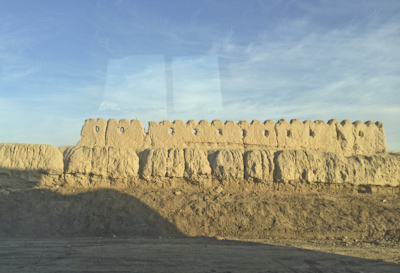 Section of the Original Ancient Wall of Khiva
Section of the Original Ancient Wall of Khiva
With the setting sun, we arrived at the walled fortress of Khiva, Uzbekistan. Our hotel was directly across the road from the East Gate pictured below. Batir told us people who were born within the gates were privileged to live within the fortress. Others had to live outside the walls in newer housing. I dropped off my luggage and went out to take photos in the fading light.
 Main Passageway Within the Walls
Main Passageway Within the Walls
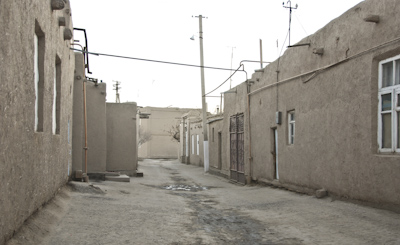 Adobe Houses – Earthen Streets
Adobe Houses – Earthen Streets
As daylight faded, I returned to the hotel for dinner and a good night’s rest. Unfortunately, when I awoke the next morning I was a victim of “Timur’s Revenge.” I spent most of the day in my room and missed the tour of Khiva. I emerged later in the afternoon feeling better and had soup for dinner. During the evening meal, we were entertained by a local family who sang and danced regional Uzbeki folk music.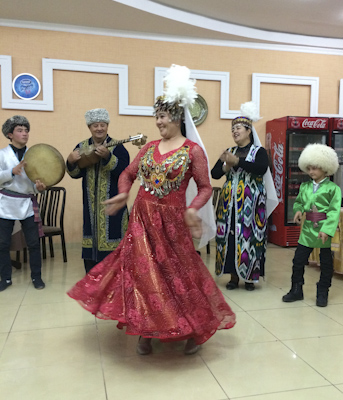
Uzbeki Folk Music and Dance
November 12, 2014 Bright sunny day – 45 – 55 F.
We met Sasha of Sasha & Son B&B. He told us we were the last guests of the season and the inn would close for the winter after we left tomorrow. After breakfast, our Golden Dragon coach drove us out of the central part of Bukhara to visit the Palace of the Moon and Stars, the summer palace of the last Emir of Bukhara.
Palace of the Moon and Stars
Interior:
Photos of the Last Emir of Bukhara:
Tourists
Chor-Minor 1806:
Back to Bukhara – we went to the USAID-UNESCO Handicraft Development Center near Lyabi-Hauz Plaza to hear several artisans talk about and demonstrate their craftsmanship.
Afterwards, we walked into one of the alleyways to visit the Jewish community center and synagogue which is the center of religious life for members. The son of the rabbi described the history of the synagogue and told us there were about 250 members. 70,000 Jews have left Uzbekistan since the dissolution of the Soviet Union.
We had another good Uzbek lunch and celebrated the birthday of one of the members of our tour group with a beautiful cake:
Then the group had the afternoon free to explore Bukhara on our own. We had a great time shopping!
Sunset in Bukhara: